Flexural Wave Propagation in Mass Chain-Filled Carbon Nanotubes
Abstract
:1. Introduction
2. Nonlocal Timoshenko Beam Model of MCSCs
3. MD Simulations for Flexural Wave Propagation in CCSC
4. Results and Discussion
5. Conclusions
- (1)
- For flexural wave propagation in MCSCs, two branches of wave dispersion relation are obtained. Taking the CCSC as an example, the MD simulation shows that the wave could hardly propagate in the CNT when the frequency is within the bandgap between the two branches. Moreover, the phase velocity of the CCSC is close to that of the SWCNT at a lower frequency, and the difference between the CCSC and the SWCNT becomes obvious when the frequency is close to the bandgap.
- (2)
- The effect of the surrounding elastic medium for the width of the bandgap can be ignored. However, it has remarkable effects for the phase velocity at a lower wave frequency.
- (3)
- The phase velocity and the width of the bandgap can be adjusted by changing the mass chain and the stiffness coefficients of the surrounding elastic medium.
Author Contributions
Funding
Conflicts of Interest
References
- Eichler, A.; Moser, J.; Chaste, J.; Zdrojek, M.; Wilson-Rae, I.; Bachtold, A. Nonlinear damping in mechanical resonators made from carbon nanotubes and graphene. Nat. Nanotechnol. 2011, 6, 339–342. [Google Scholar] [CrossRef] [PubMed]
- Dai, H.; Hafner, J.H.; Rinzler, A.G.; Colbert, D.T.; Smalley, R.E. Nanotubes as nanoprobes in scanning probe microscopy. Nature 1996, 384, 147–150. [Google Scholar] [CrossRef]
- Ulbricht, R.; Hendry, E.; Shan, J.; Heinz, T.F.; Bonn, M. Carrier dynamics in semiconductors studied with time-resolved terahertz spectroscopy. Rev. Mod. Phys. 2011, 83, 543–586. [Google Scholar] [CrossRef] [Green Version]
- Arash, B.; Wang, Q. Detection of gas atoms with carbon nanotubes. Sci. Rep. 2013, 3, 1782. [Google Scholar] [CrossRef]
- Wang, Q.; Arash, B. A review on applications of carbon nanotubes and graphenes as nano-resonator sensors. Comput. Mater. Sci. 2014, 82, 350–360. [Google Scholar] [CrossRef]
- Moser, J.; Eichler, A.; Güttinger, J.; Dykman, M.I.; Bachtold, A. Nanotube mechanical resonators with quality factors of up to 5 million. Nat. Nanotechnol. 2014, 9, 1007–1011. [Google Scholar] [CrossRef] [PubMed] [Green Version]
- Poncharal, P.; Wang, Z.L.; Ugarte, D.; De Heer, W.A. Electrostatic deflections and electromechanical resonances of carbon nanotubes. Science 1999, 283, 1513–1516. [Google Scholar] [CrossRef]
- Chaste, J.; Eichler, A.; Moser, J.; Ceballos, G.; Rurali, R.; Bachtold, A. A nanomechanical mass sensor with yoctogram resolution. Nat. Nanotechnol. 2012, 7, 301–304. [Google Scholar] [CrossRef]
- Ji, J.; Zhao, J.; Guo, W. Novel nonlinear coarse-grained potentials of carbon nanotubes. J. Mech. Phys. Solids 2019, 128, 79–104. [Google Scholar] [CrossRef]
- Meerwaldt, H.B.; Labadze, G.; Schneider, B.H.; Taspinar, A.; Blanter, Y.M.; Van Der Zant, H.S.J.; Steele, G.A. Probing the charge of a quantum dot with a nanomechanical resonator. Phys. Rev. B Condens. Matter Mater. Phys. 2012, 86, 1–15. [Google Scholar] [CrossRef]
- Willick, K.; Tang, X.S.; Baugh, J. Probing the non-linear transient response of a carbon nanotube mechanical oscillator. Appl. Phys. Lett. 2017, 111, 223108. [Google Scholar] [CrossRef]
- Steele, G.A.; Hüttel, A.K.; Witkamp, B.; Poot, M.; Meerwaldt, H.B.; Kouwenhoven, L.P.; Van Der Zant, H.S.J. Strong coupling between single-electron tunneling and nanomechanical motion. Science 2009, 325, 1103–1107. [Google Scholar] [CrossRef] [PubMed]
- Midtvedt, D.; Tarakanov, Y.; Kinaret, J. Parametric resonance in nanoelectromechanical single electron transistors. Nano Lett. 2011, 11, 1439–1442. [Google Scholar] [CrossRef] [PubMed]
- Schmid, D.R.; Stiller, P.L.; Strunk, C.; Hüttel, A.K. Magnetic damping of a carbon nanotube nano-electromechanical resonator. New J. Phys. 2012, 14, 083024. [Google Scholar] [CrossRef] [Green Version]
- Eichler, A.; Chaste, J.; Moser, J.; Bachtold, A. Parametric amplification and self-oscillation in a nanotube mechanical resonator. Nano Lett. 2011, 11, 2699–2703. [Google Scholar] [CrossRef] [PubMed]
- Lassagne, B.; Tarakanov, Y.; Kinaret, J.; David, G.S.; Bachtold, A. Coupling mechanics to charge transport in carbon nanotube mechanical resonators. Science 2009, 325, 1107–1110. [Google Scholar] [CrossRef]
- Tsioutsios, I.; Tavernarakis, A.; Osmond, J.; Verlot, P.; Bachtold, A. Real-Time Measurement of Nanotube Resonator Fluctuations in an Electron Microscope. Nano Lett. 2017, 17, 1748–1755. [Google Scholar] [CrossRef]
- Wang, L.; Hu, H.; Guo, W. Validation of the non-local elastic shell model for studying longitudinal waves in single-walled carbon nanotubes. Nanotechnology 2006, 17, 1408–1415. [Google Scholar] [CrossRef]
- Wang, L.; Hu, H. Flexural wave propagation in single-walled carbon nanotubes. Phys. Rev. B 2005, 71, 195412. [Google Scholar] [CrossRef]
- Yoon, J.; Ru, C.Q.; Mioduchowski, A. Sound wave propagation in multiwall carbon nanotubes. J. Appl. Phys. 2003, 93, 4801–4806. [Google Scholar] [CrossRef]
- Hu, Y.G.; Liew, K.M.; Wang, Q. Nonlocal elastic beam models for flexural wave propagation in double-walled carbon nanotubes. J. Appl. Phys. 2009, 106, 044301. [Google Scholar] [CrossRef]
- Li, X.F.; Wang, B.L.; Mai, Y.W. Effects of a surrounding elastic medium on flexural waves propagating in carbon nanotubes via nonlocal elasticity. J. Appl. Phys. 2008, 103, 074309. [Google Scholar] [CrossRef]
- Hummer, G.; Rasaiah, J.C.; Noworyta, J.P. Water conduction through the hydrophobic channel of a carbon nanotube. Nature 2001, 414, 188–190. [Google Scholar] [CrossRef] [PubMed]
- De, S.; Aluru, N.R. Energy Dissipation in Fluid Coupled Nanoresonators: The Effect of Phonon-Fluid Coupling. ACS Nano 2018, 12, 368–377. [Google Scholar] [CrossRef] [PubMed]
- Duan, Y.N.; Zhang, J.M.; Wei, X.M.; Fan, X.X.; Xu, K.W.; Ji, V. Structural and electronic properties of copper nanowires inside zigzag carbon nanotubes. Phys. B Condens. Matter 2014, 447, 77–82. [Google Scholar] [CrossRef]
- Scarselli, M.; Camilli, L.; Matthes, L.; Pulci, O.; Castrucci, P.; Gatto, E.; Venanzi, M.; De Crescenzi, M. Photoresponse from noble metal nanoparticles-multi walled carbon nanotube composites. Appl. Phys. Lett. 2012, 101, 3–7. [Google Scholar] [CrossRef]
- Kang, C.S.; Fujisawa, K.; Ko, Y.I.; Muramatsu, H.; Hayashi, T.; Endo, M.; Kim, H.J.; Lim, D.; Kim, J.H.; Jung, Y.C.; et al. Linear carbon chains inside multi-walled carbon nanotubes: Growth mechanism, thermal stability and electrical properties. Carbon 2016, 107, 217–224. [Google Scholar] [CrossRef] [Green Version]
- Liu, Y.; Jones, O.; Zhao, X.; Ando, Y. Carbon species confined inside carbon nanotubes: A density functional study. Phys. Rev. B Condens. Matter Mater. Phys. 2003, 68, 1–7. [Google Scholar] [CrossRef]
- Shi, L.; Rohringer, P.; Suenaga, K.; Niimi, Y.; Kotakoski, J.; Meyer, J.C.; Peterlik, H.; Wanko, M.; Cahangirov, S.; Rubio, A.; et al. Confined linear carbon chains as a route to bulk carbyne. Nat. Mater. 2016, 15, 634–639. [Google Scholar] [CrossRef]
- Hodak, M.; Girifalco, L.A. Ordered phases of fullerene molecules formed inside carbon nanotubes. Phys. Rev. B 2003, 67, 075419. [Google Scholar] [CrossRef]
- Yang, Y.; Wang, J.; Yu, Y. Wave Propagation in Fluid-Filled Single-Walled Carbon Nanotube Based on the Nonlocal Strain Gradient Theory. Acta Mech. Solida Sin. 2018, 31, 484–492. [Google Scholar] [CrossRef]
- Hu, Z.L.; Guo, X.M.; Ru, C.Q. Enhanced critical pressure for buckling of carbon nanotubes due to an inserted linear carbon chain. Nanotechnology 2008, 19, 305703. [Google Scholar] [CrossRef] [PubMed]
- Hu, Z.L.; Guo, X.M.; Ru, C.Q. The effects of an inserted linear carbon chain on the vibration of a carbon nanotube. Nanotechnology 2007, 18, 485712. [Google Scholar] [CrossRef]
- Liu, R.; Zhao, J.; Wang, L. Nonlinear vibrations of carbon chain resonators tuned by temperature. Mater. Res. Express 2017, 4, 105026. [Google Scholar] [CrossRef]
- Zhu, C.; Chen, Y.; Liu, R.; Zhao, J. Buckling behaviors of single-walled carbon nanotubes inserted with a linear carbon-atom chain. Nanotechnology 2018, 29, 335704. [Google Scholar] [CrossRef]
- Ding, D.; Zhao, Y.; Dong, S.; Yu, P.; Wang, L.; Zhao, J. The vibration of a linear carbon chain in carbon nanotubes. Materials. 2017, 10, 478. [Google Scholar] [CrossRef] [PubMed]
- Lu, L.; Ru, C.Q.; Guo, X. Negative effective mass of a filled carbon nanotube. Int. J. Mech. Sci. 2017, 134, 174–181. [Google Scholar] [CrossRef]
- Yoon, J.; Ru, C.Q. Metamaterial-like vibration of doublewalled carbon nanotubes. Phys. E Low Dimens. Syst. Nanostruct. 2019, 107, 196–202. [Google Scholar] [CrossRef]
- Brenner, D.W.; Shenderova, O.A.; Harrison, J.A.; Stuart, S.J.; Ni, B.; Sinnott, S.B. A second-generation reactive empirical bond order (REBO) potential energy expression for hydrocarbons. J. Phys. Condens. Matter 2002, 14, 783–802. [Google Scholar] [CrossRef]

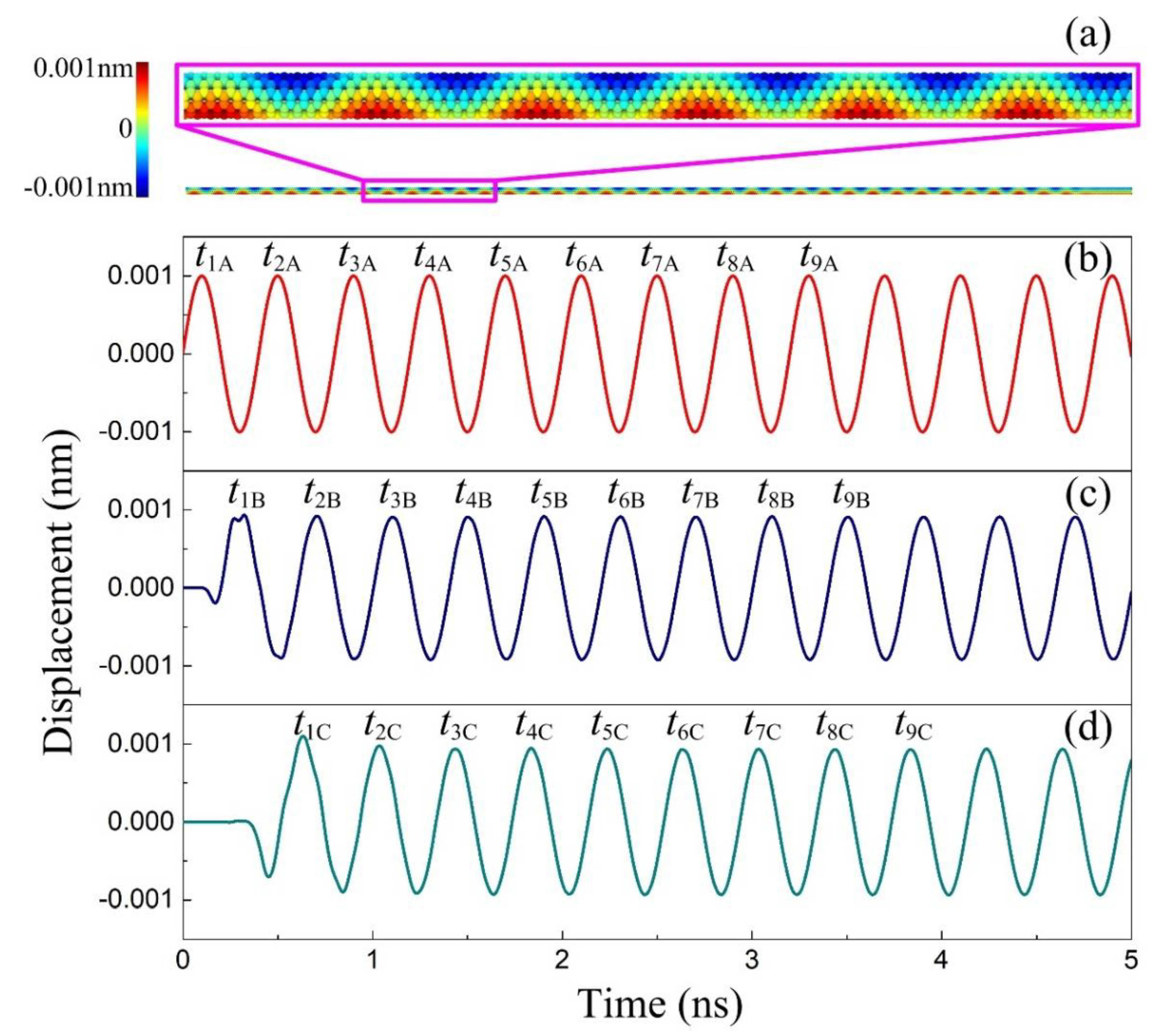
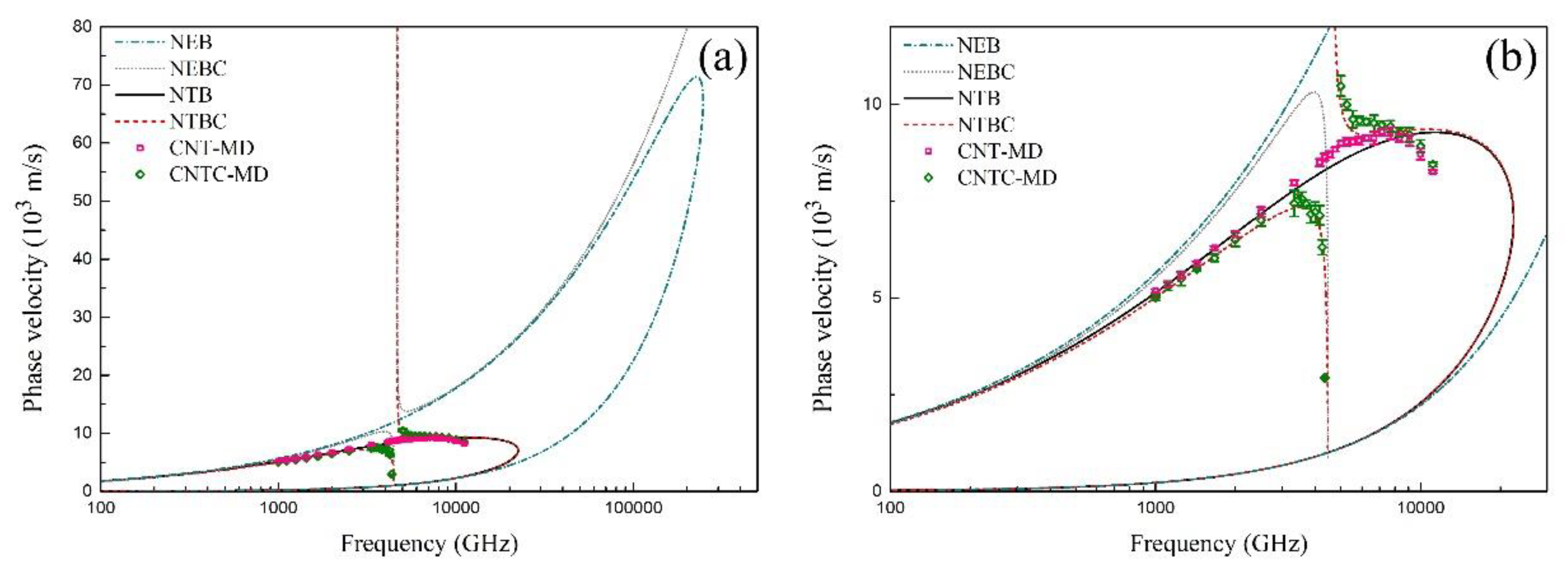
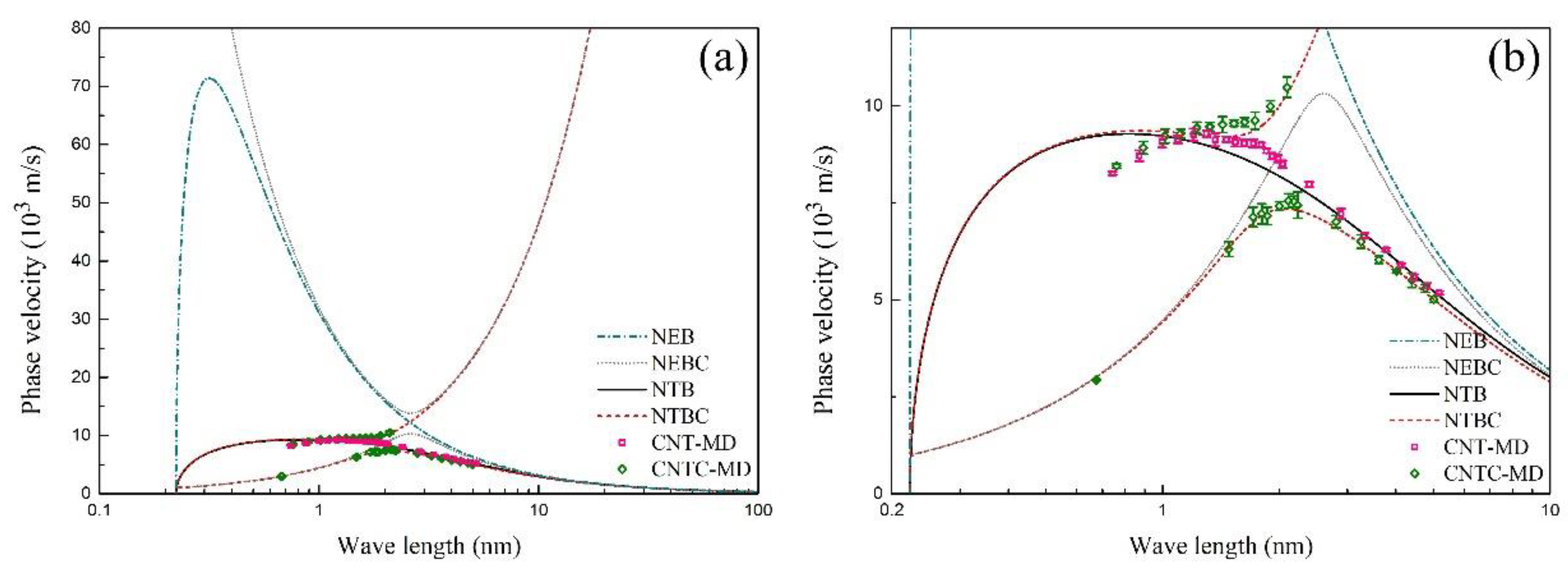

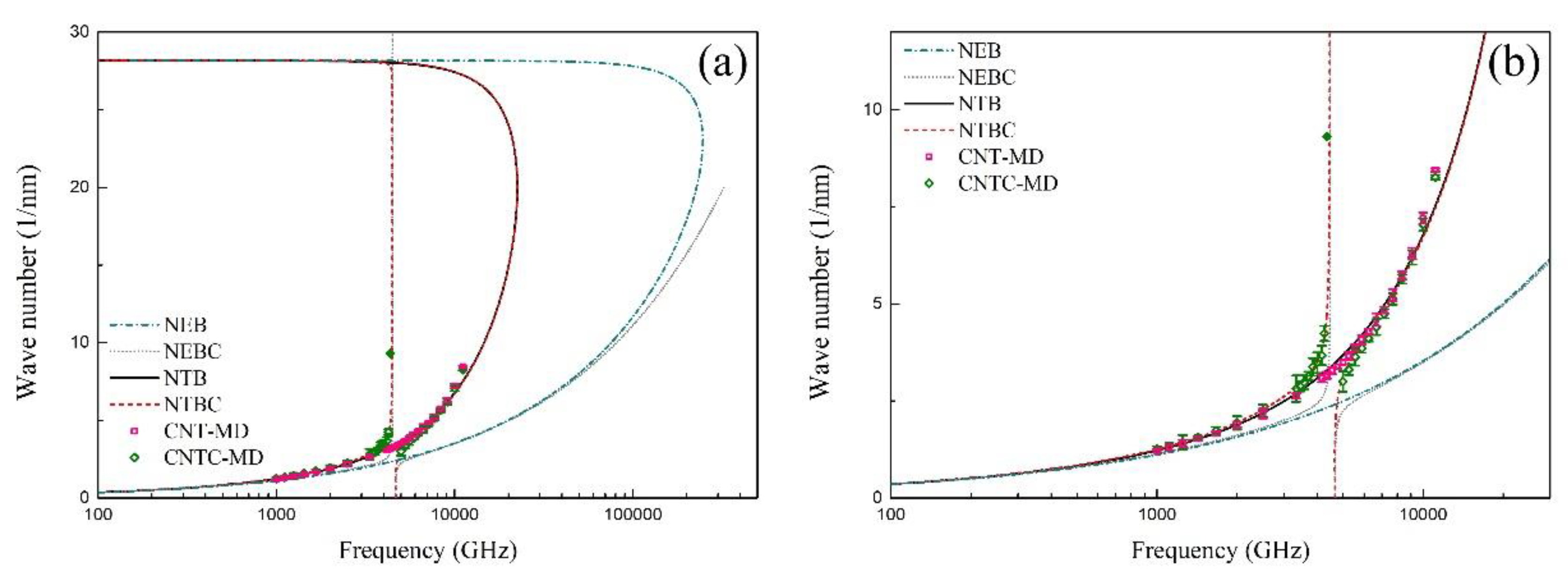
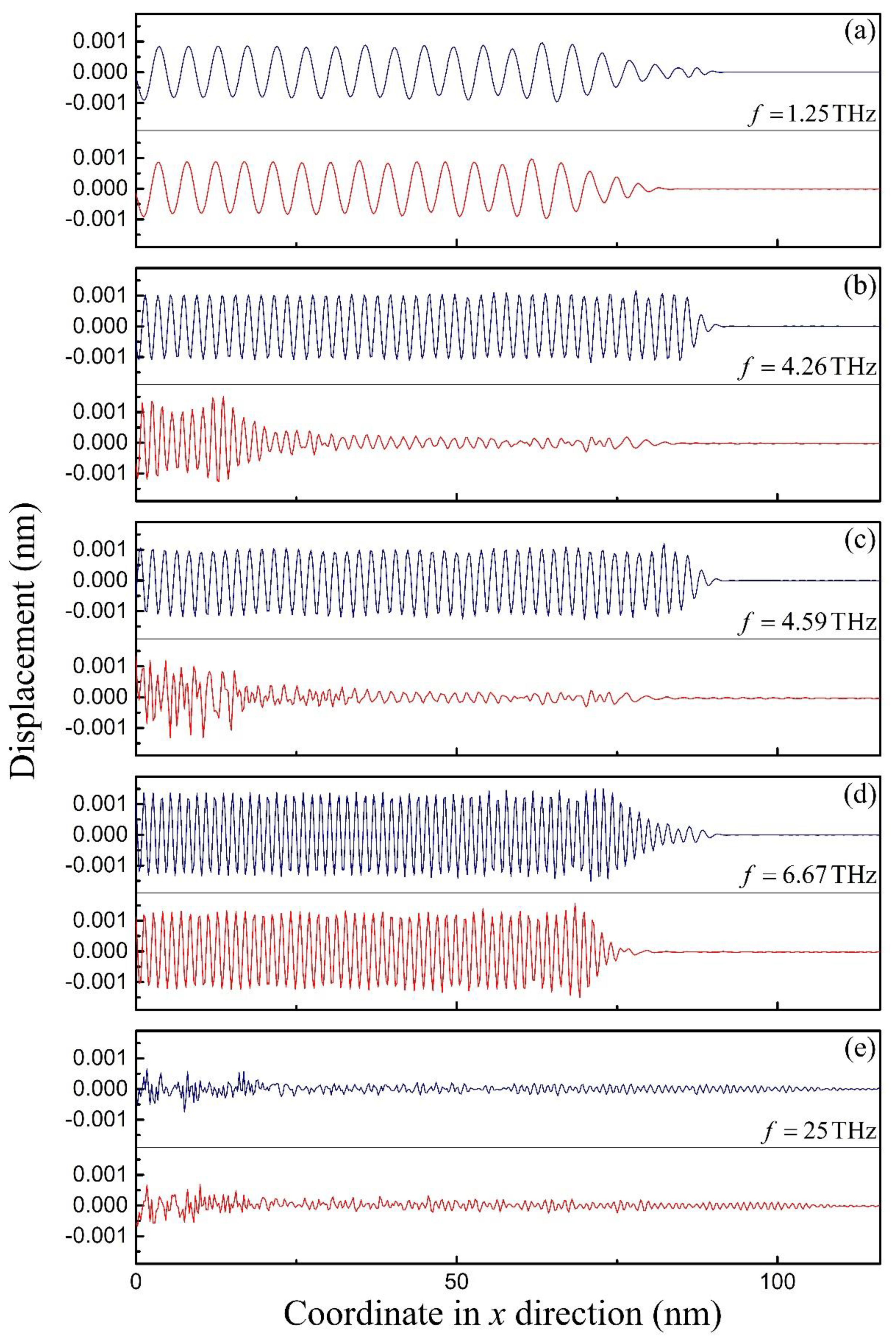
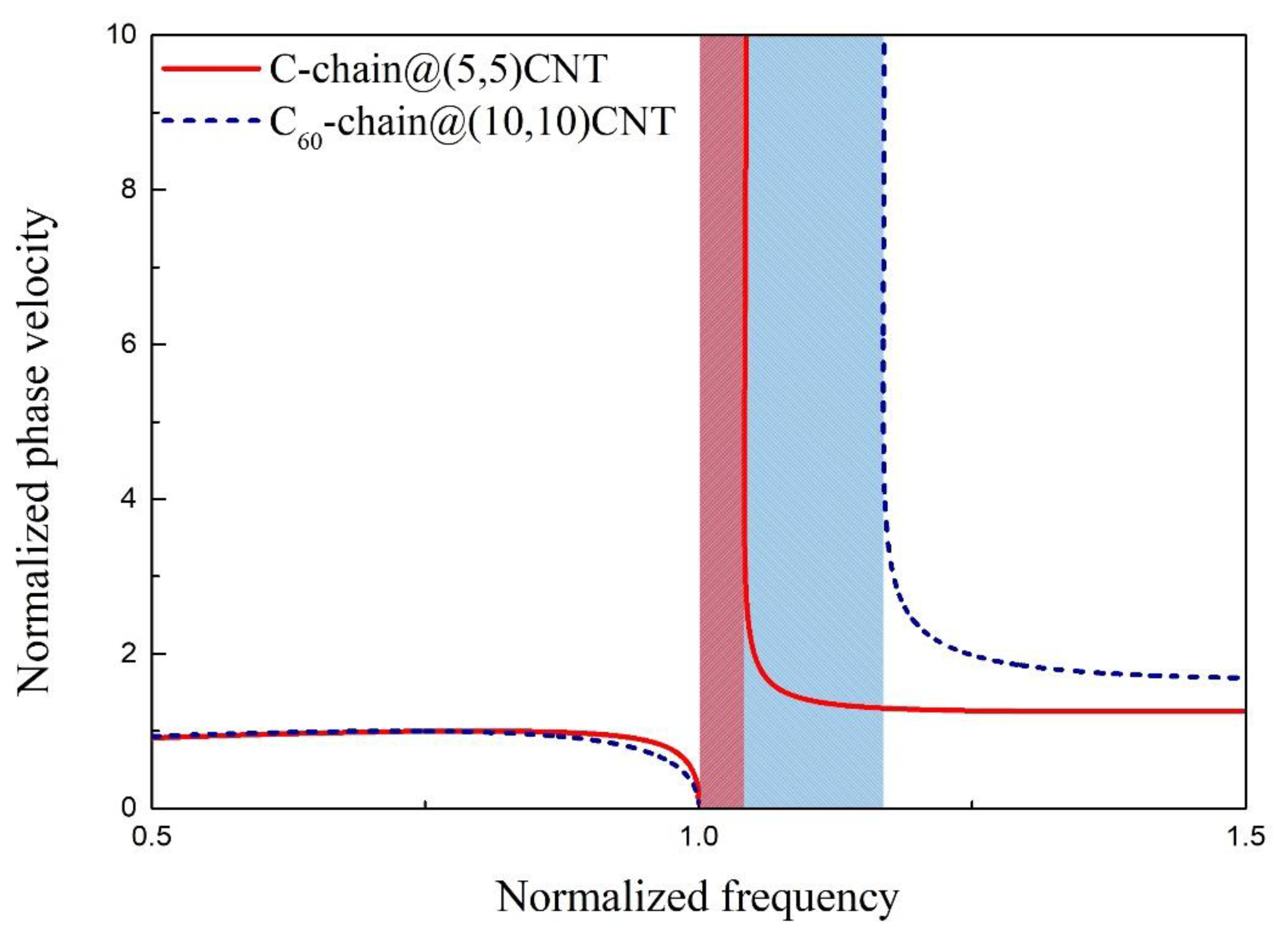
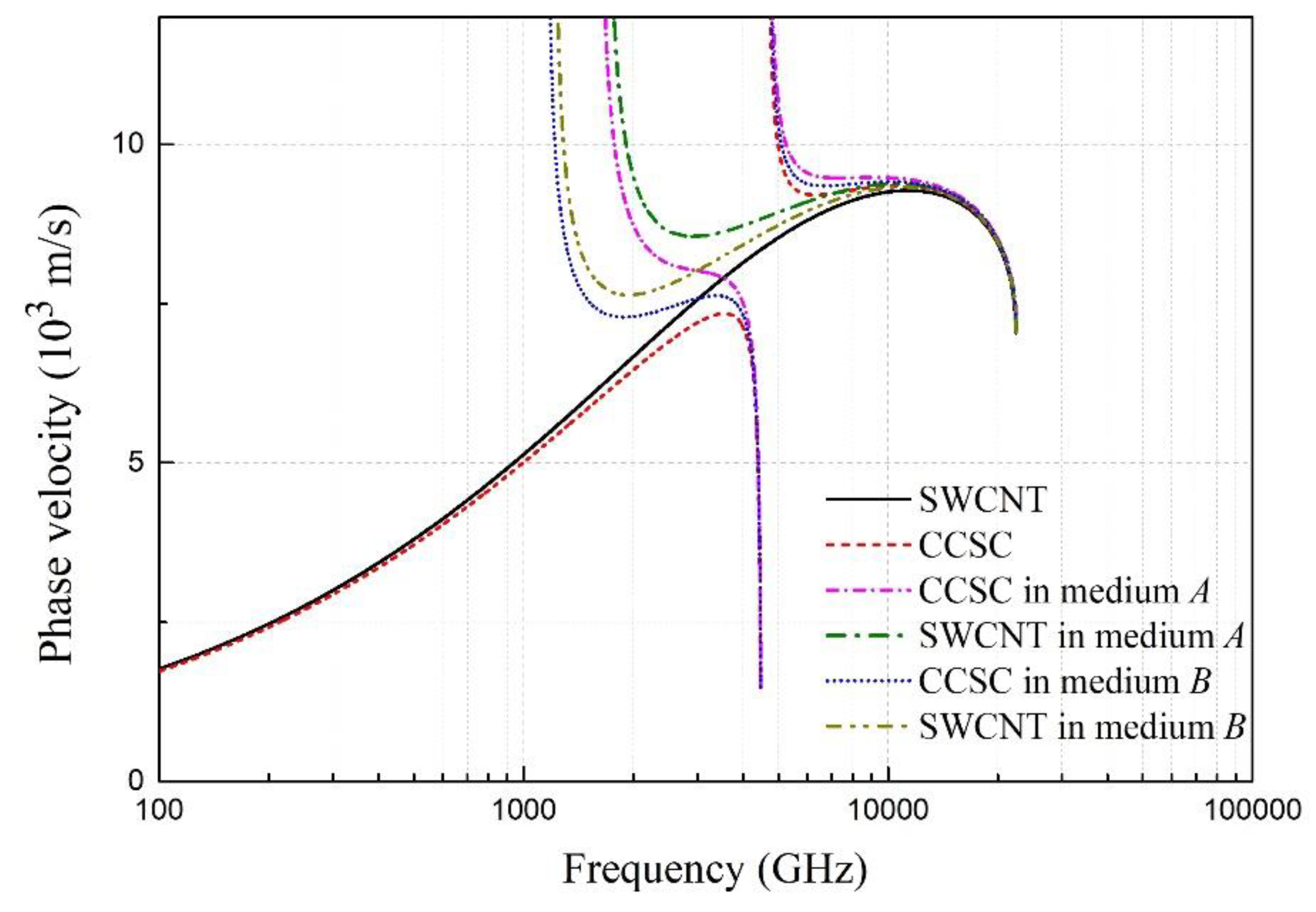
© 2019 by the authors. Licensee MDPI, Basel, Switzerland. This article is an open access article distributed under the terms and conditions of the Creative Commons Attribution (CC BY) license (http://creativecommons.org/licenses/by/4.0/).
Share and Cite
Liu, R.; Zhao, J.; Wang, L. Flexural Wave Propagation in Mass Chain-Filled Carbon Nanotubes. Materials 2019, 12, 2986. https://doi.org/10.3390/ma12182986
Liu R, Zhao J, Wang L. Flexural Wave Propagation in Mass Chain-Filled Carbon Nanotubes. Materials. 2019; 12(18):2986. https://doi.org/10.3390/ma12182986
Chicago/Turabian StyleLiu, Rumeng, Junhua Zhao, and Lifeng Wang. 2019. "Flexural Wave Propagation in Mass Chain-Filled Carbon Nanotubes" Materials 12, no. 18: 2986. https://doi.org/10.3390/ma12182986



